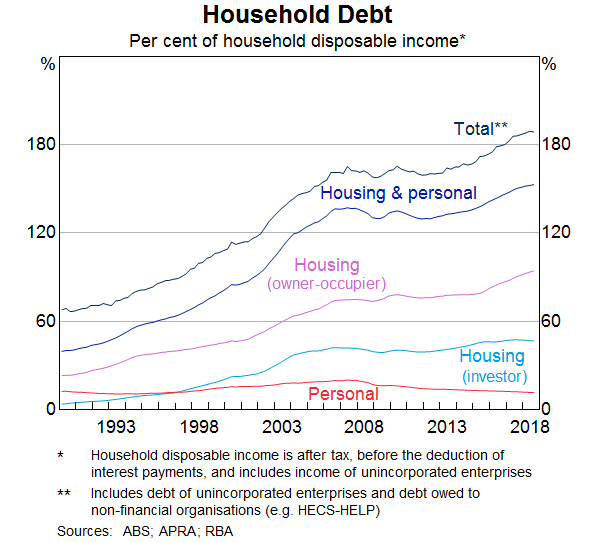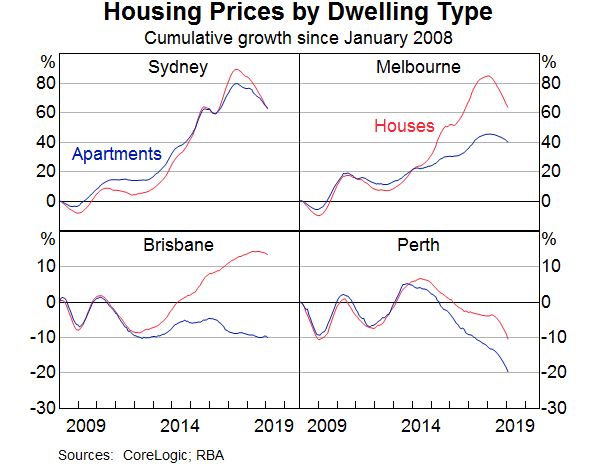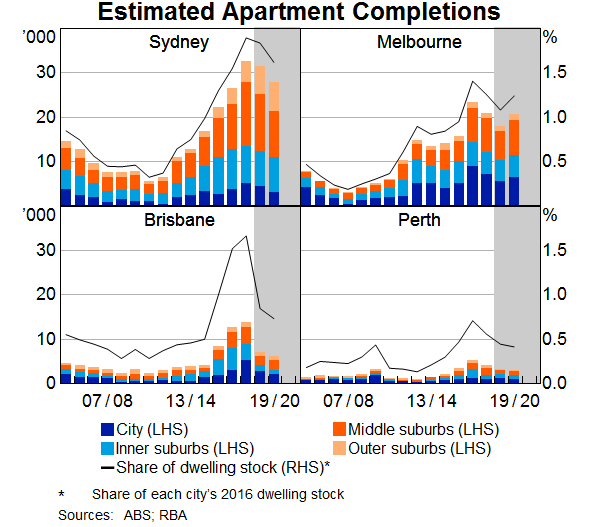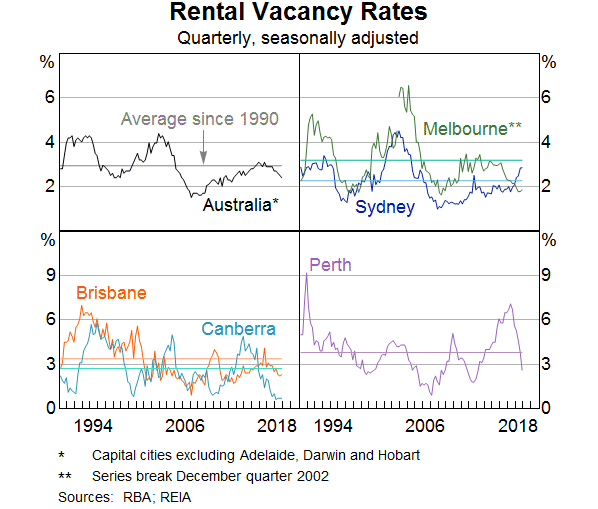The Reserve Bank of Australia sees heightened risks for sectors of our housing markets.
There are "heightened risks" to financial stability from the huge wave of apartment building have become "elevated" according to assistant governor Michele Bullock but she explained that any uncertainties about investing in property are "contained."
The key points of her recent speech:
- Ms Bullock encouraged the banks to start lending again saying" “Please think hard about whether your lending standards are too tight”
- Bullock suggested: “The appropriate amount of credit risk is not zero, banks need to continue to lend and that will inevitably involve some credit losses."
- Ms Bullock said two vulnerabilities - the level of household debt, and the slowdown in housing and credit markets remained in the system - and that "if anything, they are a little more heightened" than six months ago.
- More than 80,000 apartments have been completed in Sydney over the past few years, adding roughly 5 per cent to the city's housing stock.
- There have been also been relatively large additions to the supply of apartments in Melbourne and Brisbane.
- This has created two risks.
- Firstly to household balance sheets where buyers have purchased off the plan but on completion the value is lower and they have to draw more on their savings or loans from other sources.
- The second risk is to developers who are delivering completed apartments into the cooling market and are exposed to increasing settlement failures from investors who can't afford to go ahead with their purchase.
Now there's nothing really new about this.
Thousands of investors face financial ruin because they won’t be able to settle the “off the plan” apartments they signed up to buy.
I've written about this before...industry insiders are worrying about a ticking time bomb, that the average property punter is not aware.
A recent report prepared by Corelogic for The Australian shows that nearly half of the new apartments that were settled last month in Sydney and Melbourne markets had valuations that came in at less than the buyer paid.
Many of those investors committed to their purchase a number of years ago when the climate was very different.
CoreLogic found that 45 per cent of new apartments in Sydney settled last month with valuations which were undertaken at the completion of the project so the purchaser could obtain finance —were below the off-the-plan purchase price, up from 18 per cent a year ago.
In Melbourne, 46 per cent of investors settling on their properties found they overpaid as mortgage valuations fell below their purchase price.
This compares with 23 per cent a year ago.
At the time these investors made their original purchases sentiment was high, foreign investors were clamouring to buy off the plan apartments in our two big capital cities – Sydney and Melbourne; and local investors were happy to put down a small deposit anticipating strong capital growth prior to completion.
So this is the RBA's current view on property risk
Here is an edited version of the speech the assistant governor gave to the Urban Development Institute in Perth on March 20th...
As Assistant Governor (Financial System) I oversee the Bank's work on financial stability.
But what is financial stability and what is the Reserve Bank's role in it?
The wellbeing of households and businesses in Australia depends on growth in the Australian economy.
And a crucial facilitator of sustained growth is credit – flows of funds from people who are saving to people who are investing.
Credit provides households and businesses with the ability to borrow on the back of future expected income to finance large outlays, for example, the purchase of a home or equipment to establish or grow a business. A strong and stable financial system is important for this flow of funds.
There is no universal definition of financial stability but one way to think about it is to consider what is meant by financial instability.
My colleague Luci Ellis suggested that this is best thought of as a disruption in the financial sector so severe that it materially harms the real economy.
This leaves unsaid where the disruption might come from, but we would all recognise the outcomes of financial stability when we see it.
For example, while Australia was spared the worst impact of the global financial crisis, internationally it demonstrated the impact that financial instability can have on growth and hence the wellbeing of households and businesses in the economy.
Most of you will know about the Reserve Bank's role in conducting monetary policy.
But another key role of the Reserve Bank that you might be less familiar with is promoting financial stability.
In this area, we share responsibility with the Australian Prudential Regulation Authority (APRA).
But it is APRA that has responsibility for the stability of individual financial institutions and the tools that go along with that. So how does the Bank contribute to financial stability?
There are a number of things we do.
We undertake analysis of the economy and the financial system through the lens of financial stability, looking for financial vulnerabilities that could result in substantial negative impacts on the economy, or economic vulnerabilities that could result in risks to financial stability.
We work with other regulators to identify signs of increasing risks in the financial system and measures to address these risks.
Where appropriate, we provide advice to government on the potential implications for financial stability of policies.
And we talk about the risks we are seeing to help inform other regulators, participants in the financial system, businesses and the general public of the potential risks that might have an impact on the economy.
This last action – communicating the risks – is the key purpose of our six-monthly Financial Stability Review (the Review).
While any individual financial institution, business or household might think the risks they are taking on are appropriate, they may not be adequately taking into account the risks that are arising at a systemic level from everyone's actions.
Household Debt
Six months ago in the Review, we noted that global economic and financial conditions were generally positive and that the Australian economy was improving.
At the same time, housing prices were declining.
In this context, we highlighted a number of vulnerabilities – issues that, were a shock to occur or economic conditions take a turn for the worse, could manifest in a threat to financial stability.
At that time, we highlighted two domestic vulnerabilities that are relevant to my talk today – the level of household debt, and the slowdown in housing and credit markets.
Six months on, these vulnerabilities remain.
If anything, they are a little more heightened.
The Bank has highlighted the issue of household debt as a potential threat to financial stability many times over the past few years.
Although it does not capture all the important information about household indebtedness, the ratio of household debt to disposable income is one summary indicator.
This ratio is historically high (Graph 1).
The household debt-to-income ratio rose from around 70 per cent at the beginning of the 1990s to around 160 per cent at the time of the GFC.
The ratio steadied for a few years before starting to rise again around 2013 (around the same time that housing price growth began to accelerate) and is now around 190 per cent.

I have talked previously about some of the reasons why the debt-to-income ratio has risen so much over the past few decades.
In particular, a structural decline in the level of nominal interest rates and deregulation have eased credit constraints and increased loan serviceability.
And as households have been able to borrow more, they have been able to pay more for housing.
One important driver of high household debt in Australia is, therefore, housing.
There is very little debt related to non-housing loans such as credit cards or car loans.
Just as housing costs have been an important driver of household debt, so has the ability to borrow more influenced the price of housing.
Over the past decade, housing prices in many parts of Australia have risen but the rise has been particularly sharp in Sydney and Melbourne, which account for around 40 per cent of the housing stock (Graph 2).
More recently, housing prices have fallen.
Since the peak in mid 2017, housing prices Australia-wide have declined by around 7 per cent.
The falls in Sydney and Melbourne have been larger. The question we are asking ourselves is, given the high levels of debt and falling housing prices, are there any significant implications for financial stability?

The answer would be no at this stage – the impacts are not large enough to result in widespread problems in the financial sector.
This is not to downplay the financial stress that some households are experiencing.
But most of the debt remains well secured against property, even with the decline in housing prices.
Total repayments as a share of income remain steady and a large number of indebted households have built up substantial prepayments over the past few years.
Broadly, the debt is held by households that can afford to service it.
Arrears rates, while increasing a bit over the past few years, remain low.
Banks are well capitalised and work over recent years to improve lending standards has made household and bank balance sheets more resilient.
Loans at high loan-to-valuation (LVR) ratios and interest-only loans are less common than they were and most households have not been borrowing the maximum amount available.
Apartment Development
One area that we have focused on in recent years in our analysis of financial stability risks is apartment development.
There has been a substantial increase in apartment construction since the start of the decade in the largest Australian capital cities (Graph 3).
In Sydney there have been more than 80,000 apartments completed over the past few years adding roughly 5 per cent to housing stock in Sydney.
Melbourne and Brisbane have also seen relatively large additions to the supply of apartments and, while the number of apartments being built in Perth has been small by comparison, this has been in the context of a fairly small apartment stock.

By its nature, high-density development can tend to exacerbate price cycles.
Our main concern with this from a financial stability perspective is the potential for this large influx of supply to exacerbate declines in housing prices and so adversely impact households' and developers' financial positions.
Large apartment developments have longer planning and development processes than detached housing.
Purchasing the land, designing the development, getting approvals through relevant government bodies and then actual construction of the apartment block all take time.
In a climate of rapidly rising prices, developers are willing to pay high prices for land on which to build apartments.
Households, including investors, are willing to purchase apartments off the plan, confident that the apartment will be worth more than they paid for it when it is finally completed.
This continues as long as prices are rising.
This large increase in supply, however, ultimately sows the seeds of a decline in prices which, if large enough, results in development becoming unattractive, new supply falling and the cycle starting again.
This presents two risks.
- The first is to household balance sheets.
A decline in apartment prices could negatively impact households that purchased off the plan and are yet to settle.
They might find themselves in a situation where the value of the apartment in the current environment is less than they contracted to pay for it.
And as market pricing falls, lenders will revise their valuations down and so will be willing to lend less.
Households will therefore have to contribute more funds, either from their own savings or loans from other sources. - The second risk is to developers who are delivering completed apartments into the cooling market.
If people who had pre-purchased are having difficulty getting finance, or decide it is not worth going ahead with the purchase, there would be increasing settlement failures.
Developers would be left holding completed apartments, reducing their cash flow and their ability to service their loans, and impacting banks' balance sheets.
Currently, the risks here appear to be elevated but contained.
The apartment market is quite soft in Sydney; apartment prices have declined since their peak, rental vacancies have risen and rents are falling (Graph 4).
In Melbourne and Brisbane, however, apartment prices have so far held up.
Liaison suggests that settlement failures have not increased much and, to the extent that they have, some developers are in a position where they can choose to hold and rent unsold apartments.
Further tightening in lending standards might, however, impact both purchasers of new apartments and developers – I will return to this in a minute.

Read the full speech here: Property, Debt and Financial Stability























